Experimental Investigation of a New Design of Insulation Gypsum Plaster Blocks
Abstract
:1. Introduction
2. Experimental Program
- -
- Evaluate the chemical, physical, and mineral properties of the gypsum plaster used in this study, such as:
- Chemical composition using an X-ray fluorescence spectrometry (XRF).
- Microstructure analysis by scanning electron microscope.
- Particle size analysis.
- Densities.
- Blaine specific surface (BSS).
- -
- Mix design of gypsum plaster and water mixture in order to determine the optimal mixture composition.
- -
- Study of the mechanical and the physical properties of gypsum and water mixture, such as:
- Density.
- Water absorption.
- Temperature of hydration.
- Compressive strength.
- -
- Preparation of the block prototypes.
- -
- Study of the mechanical and the physical properties of gypsum plaster block prototype:
- Dimensional tolerances.
- Density.
- Compressive strength.
- Flatness.
- Residual moisture.
- Water absorption.
- Surface hardness.
- Thermal conductivity.
3. Materials and Methods
3.1. Gypsum Plaster
3.1.1. Chemical Analysis
3.1.2. Microstructure Analysis by Scanning Electron Microscope
3.1.3. Particle Size Analysis
3.1.4. Physical Properties
3.2. Tests Setup on Gypsum Plaster and Water Mixture
3.2.1. Mix Design of the Mixture
3.2.2. Test Specimens Preparation
- ▪
- Add the gypsum plaster amount to 60% water (Figure 6a).
- ▪
- Mix in wet condition first for 30 s with slow speed and then for 1 min with high speed (Figure 6b).
- ▪
- Prepare the molds (Figure 6c,d).
- ▪
- Pour the mixture on the molds (Figure 6e).
- ▪
- Dry the specimens for 10 min before demolding (Figure 6f,g).
- ▪
- Demold the specimens (Figure 6h).
- ▪
- Finally, keep specimens under a temperature degree of 23 °C and a relative humidity between 55 and 65% to the testing date.
3.2.3. Density
3.2.4. Water Absorption Degree
3.2.5. Temperature of Hydration
3.2.6. Compressive Strength
4. Properties of Gypsum Plaster and Water Mixture
4.1. Density
4.2. Degree of Absorption
4.3. Temperature of Hydration
4.4. Compressive Strength
5. Design of New Gypsum Plaster Blocks
5.1. New Blocks Description
5.2. Manufacturing of Gypsum Plaster Block Prototypes
- -
- Dimensional tolerances.
- -
- Density.
- -
- Surface hardness.
- -
- Residual moisture.
- -
- Thermal conductivity.
- -
- Compressive strength.
- -
- Flatness.
5.3. Properties of Gypsum Plaster Blocks
5.3.1. Dimensional Tolerances
5.3.2. Flatness
5.3.3. Density
5.3.4. Compressive Strength
5.3.5. Residual Moisture
5.3.6. Water Absorption
5.3.7. Surface Hardness
5.3.8. Thermal Conductivity
5.4. Discussion
- -
- They have a tolerated dimensions after drying.
- -
- They have a flat surface.
- -
- They are considered lightweight blocks because of their very low density, about 865 kg/m3.
- -
- They have a recommended compressive strength for wall construction.
- -
- They can be used only after one day because of their very quick setting.
- The construction of the walls by the new blocks is very easy and very fast due to the flat surfaces and to the similarity in size of blocks.
- Compared with the ordinary brick blocks, the mortar consumption is considerably low.
- The possibility of faience attachment was observed.
- There are no cracks observed at joints between blocks.
6. Conclusions
- -
- Gypsum plaster blocks have a tolerated dimensions after drying.
- -
- The flatness index shows that gypsum plaster blocks have a flat surface.
- -
- Gypsum plaster blocks can be considered as average density blocks because of their very low density.
- -
- Gypsum plaster blocks have a recommended compressive strength for wall construction.
- -
- Gypsum plaster blocks have very quick setting.
- -
- The construction of the walls by the new blocks is very easy and very fast due to the flat surfaces and to the similarity in size of blocks.
- -
- Because these gypsum blocks are very sensitive to water, they are not intended for dry zones.
Author Contributions
Funding
Institutional Review Board Statement
Informed Consent Statement
Data Availability Statement
Acknowledgments
Conflicts of Interest
Collaborators
References
- Morgan, D.J. Thermal analysis including evolved gas analysis of clay raw materials. Appl. Clay Sci. 1993, 8, 81–89. [Google Scholar] [CrossRef]
- Santos, D.R.; Toledo, R.; Faria, R.T., Jr.; Carrio, J.G.; Da Silva, M.G.; Auler, L.T. Evolved gas analysis of clay materials. Rev. Sci. Instrum. 2003, 74, 663–666. [Google Scholar] [CrossRef]
- Toledo, R.; dos Santos, D.R.; Faria, R.T., Jr.; Carrio, J.G.; Auler, L.T.; Vargas, H. Gas release during clay firing and evolution of ceramic properties. Appl. Clay Sci. 2004, 27, 151–157. [Google Scholar] [CrossRef]
- Gonzalez, I.; Galan, E.; Miras, A.; Vazquez, M.A. CO2 emissions derived from raw materials used in brick factories. Applications to Andalusia (Southern Spain). Appl. Clay Sci. 2011, 52, 193–198. [Google Scholar] [CrossRef]
- Cusido, J.A.; Cremades, L.V.; Gonzalez, M. Gaseous emissions from ceramics manufactured with urban sewage sludge during firing processes. Waste Manage. 2003, 23, 273–280. [Google Scholar] [CrossRef]
- Mansour, B.M.; Soukaina, A.C.; Benhamou, B.; Jabrallah, B.S. Thermal characterization of a Tunisian gypsum plaster as Construction Material. Energy Proc. 2013, 42, 680–688. [Google Scholar] [CrossRef]
- Xamán, J.; Lira, L.; Arce, J. Analysis of the temperature distribution in a guarded hot plate apparatus for measuring thermal conductivity. Appl. Therm. Eng. 2009, 29, 617–623. [Google Scholar] [CrossRef]
- Salmon, D. Thermal conductivity of insulations using guarded hot plates, including recent developments and source of reference materials. Meas. Sci. Technol. 2001, 12, 89–98. [Google Scholar] [CrossRef]
- Fabio, S.M.; Renata, N.T. Infrared thermography applied to the quantitative determination of spatial and thermophysical parameters of hidden included objects. Appl. Therm. Eng. 2007, 27, 2378–2384. [Google Scholar]
- Jannot, Y.; Zoubir, A. A quadrupolar complete model of the hot disc. Meas. Sci. Technol. 2007, 18, 1229–1234. [Google Scholar] [CrossRef]
- Jannot, Y.; Meukam, P. Simplified estimation method for the determination of thermal effusivity and thermal conductivity with a low cost hot strip. Meas. Sci. Technol. 2004, 15, 1932–1938. [Google Scholar] [CrossRef]
- Coquard, D.; Baillis, D.; Quenard, D. Experimental and theoretical study of the hot-wire method applied to low-density thermal insulators. Int. J. Heat Mass Transf. 2006, 49, 4511–4524. [Google Scholar] [CrossRef]
- Koksal, F.; Gencel, O.; Kaya, M. Combined effect of silica fume and expanded vermiculite on properties of lightweight mortars at ambient and elevated temperatures. Constr. Build. Mater. 2015, 88, 175–187. [Google Scholar] [CrossRef]
- Korjenic, A.; Zach, J.; Hroudová, J.; Petránek, V.; Korjenic, S.; Bednar, T. Development and optimization of advanced silicate plasters materials for building rehabilitation. In Proceedings of the 2nd Central European Symposium on Building Physics, Vienna, Austria, 9–11 September 2013; pp. 863–867. [Google Scholar]
- Václavík, V.; Daxner, J.; Valíček, J.; Dvorský, T.; Kušnerová, M.; Harničárová, M.; Bendová, M.; Břenek, A. The use of industrial waste as a secondary raw material in restoration plaster with thermal insulating effect. Adv. Mat. Res. 2014, 897, 204–214. [Google Scholar] [CrossRef]
- Vieira, J.; Senff, L.; Goncalves, H.; Silva, L.; Ferreira, V.M.; Labrincha, J.A. Functionalization of mortars for controlling the indoor ambient of buildings. Energ. Build. 2014, 70, 224–236. [Google Scholar] [CrossRef]
- Hroudová, J.; Zach, J.; Hela, R.; Korjenic, A. Advanced, Thermal Insulation Materials Suitable for Insulation and Repair of Buildings. Adv. Mat. Res. 2013, 688, 54–59. [Google Scholar] [CrossRef]
- Zach, J.; Korjenic, A.; Hroudová, J. Study of behaviour of advanced silicate materials for heating and moisture rehabilitation of buildings. Adv. Mat. Res. 2013, 649, 167–170. [Google Scholar]
- Gencel, O.; Diaz, J.J.C.; Sutcu, M.; Koksal, F.; Rabanal, F.P.A.; Barrera, G.M.; Brostow, W. Properties of gypsum composites containing vermiculite and polypropylene fibers: Numerical and experimental result. Constr. Build. Mater. 2014, 70, 135–144. [Google Scholar] [CrossRef]
- Khalil, A.A.; Tawfik, A.; Hegazy, A.A.; El-Shahal, M.F. Effect of some waste additives on the physical and mechanical properties of gypsum plaster composites. Constr. Build. Mater. 2014, 68, 580–586. [Google Scholar] [CrossRef]
- Benazzouk, A.; Douzane, O.; Mezreb, K.; Laidoudi, B.; Queneudec, M. Thermal conductivity of cement composites containing rubber waste particles, experimental study and modelling. Constr. Build. Mater. 2008, 22, 573–579. [Google Scholar] [CrossRef]
- NF P94-057; Soils Investingation and Testing. Granulometric Analysis. Hydrometer Method. May 1992. Available online: https://www.boutique.afnor.org/en-gb/standard/nf-p94057/soils-investingation-and-testing-granulometric-analysis-hydrometer-method/fa020768/11074#AreasStoreProductsSummaryView (accessed on 19 May 2022).
- ASTM Standard D2487; Standard Practice for Classification of Soils for Engineering Purposes (Unified Soil Classification System). ASTM International: West Conshohocken, PA, USA, 2000.
- NF EN 196; Methods of Testing Cements—Part 6: Determination of Fineness. 6 April 2012. Available online: https://www.boutique.afnor.org/en-gb/standard/nf-en-1966/methods-of-testing-cement-determination-of-fineness/fa187053/83194 (accessed on 19 May 2022).
- NF EN 1097-7; Tests for Mechanical and Physical Properties of Aggregates—Part 7: Determination of the Particle Density of Filler-Pyknometer Method. June 2008. Available online: https://www.boutique.afnor.org/en-gb/standard/nf-en-10977/tests-for-mechanical-and-physical-properties-of-aggregates-part-7-determina/fa155696/31162 (accessed on 19 May 2022).
- NF EN 12390; Testing Hardened Concrete-Part4: Compression Strength-Specification for Testing Machines, European Committee for Standardization CEN: Brussels, Belgium, 2009. Available online: https://www.boutique.afnor.org/en-gb/results?Keywords=NF+EN+12390&StandardStateIds=1 (accessed on 19 May 2022).
- Alyousef, R.; Benjeddou, O.; Soussi, C.; Khadimallah, M.A.; Jedidi, M. Experimental Study of New Insulation Lightweight Concrete Block Floor Based on Perlite Aggregate. Adv. Mater. Sci. Eng. 2019, 2019, 8160461. [Google Scholar] [CrossRef]
- Ben Mansour, M.; Cherif, A.S.; Ben Jabrallah, S.; Benhamou, B. Caractérisation thermique d’un plâtre de gypse tunisien utilisé en tant que matériau de construction. In Proceedings of the EcoMAT2013, Ougadougou, Burkina Faso, 10–12 June 2013. [Google Scholar]
- NF EN 12859; Gypsum Blocks-Definitions, Requirements and Test Methods. April 2011. Available online: https://www.boutique.afnor.org/en-gb/results?Keywords=NF+EN+12859&StandardStateIds=1 (accessed on 19 May 2022).
- NF EN 772-21; Methods of Test for Masonry Units—Part 21: Determination of Water Absorption of Clay and Calcium Silicate Masonry Units by Cold Water Absorption. August 2011. Available online: https://www.boutique.afnor.org/en-gb/results?Keywords=NF+EN+772-21&StandardStateIds=1 (accessed on 19 May 2022).
- NF EN ISO 8990; Thermal Insulation-Determination of Steady-State Thermal Transmission Properties-Calibrated and Guarded Hot Box. 1996. Available online: https://www.boutique.afnor.org/en-gb/results?Keywords=NF+EN+ISO+8990&StandardStateIds=1 (accessed on 19 May 2022).

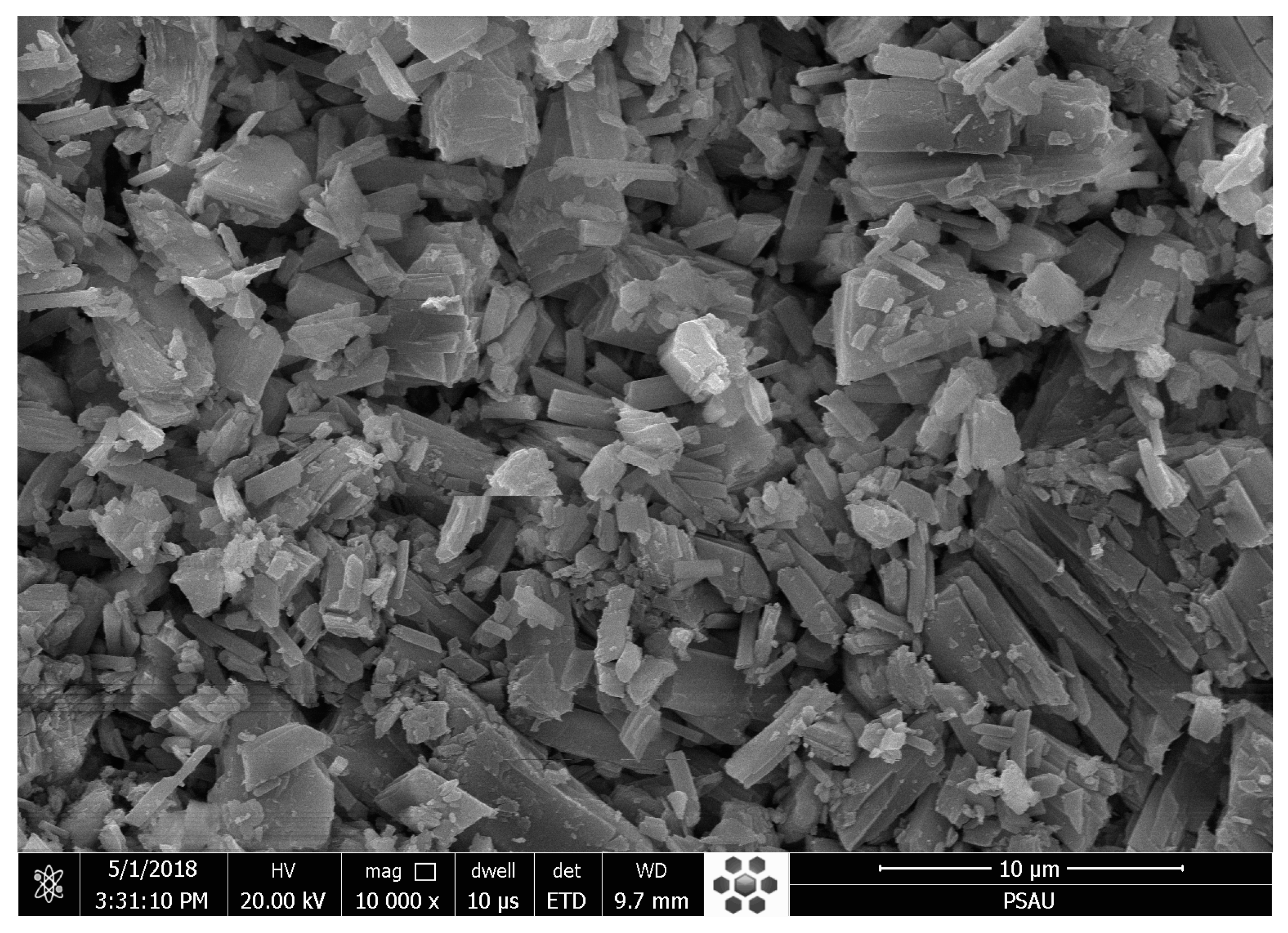
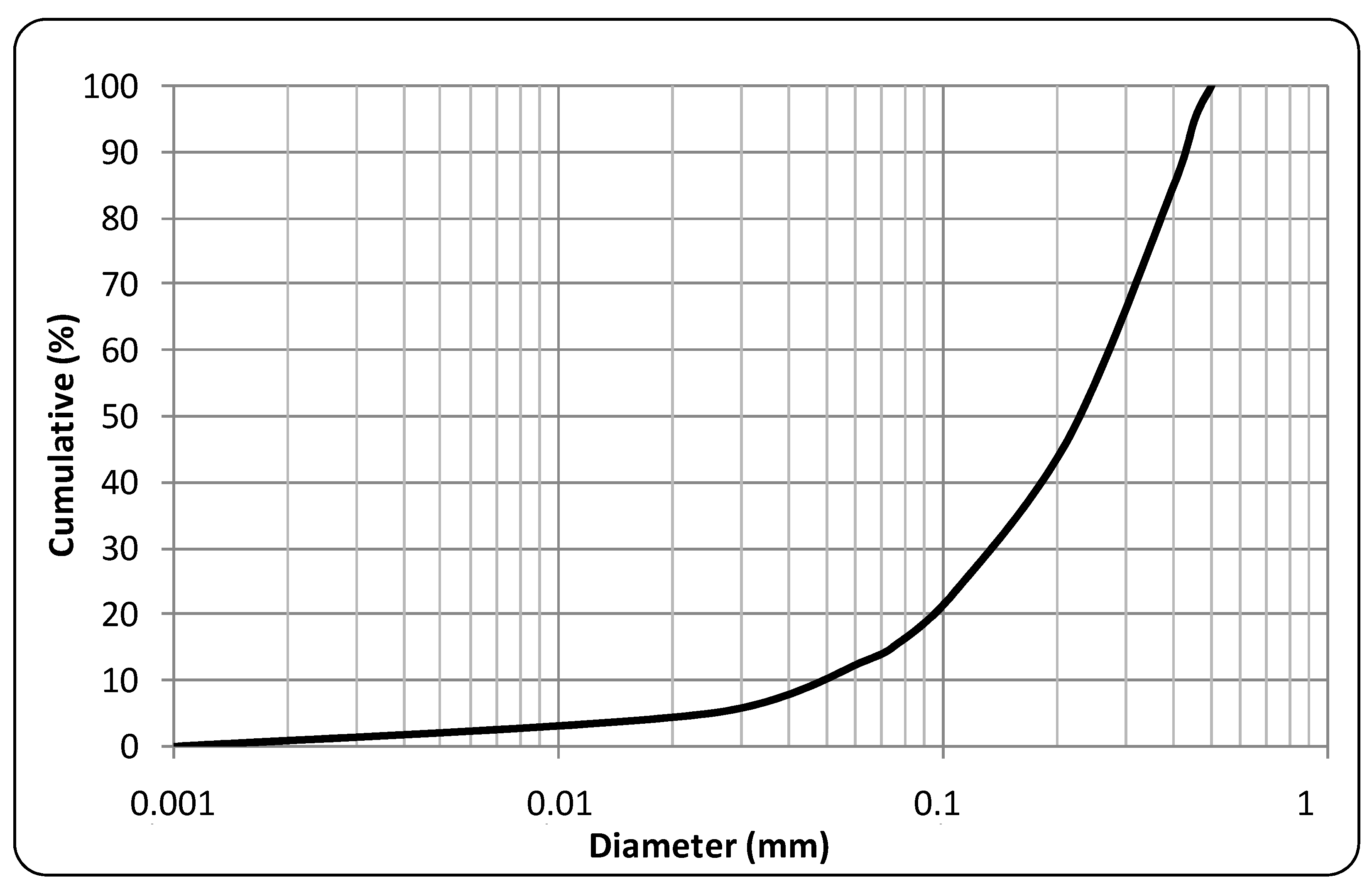



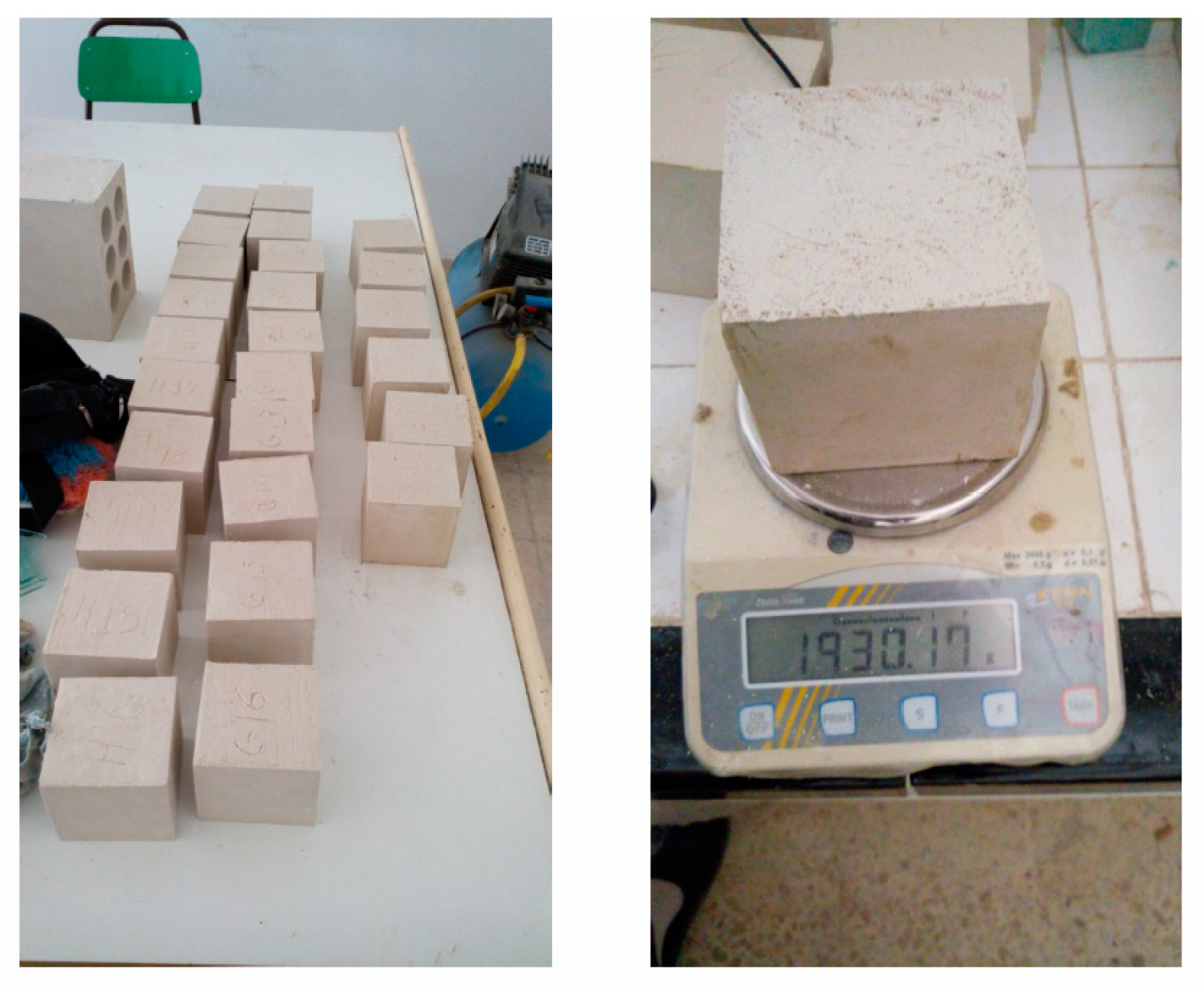

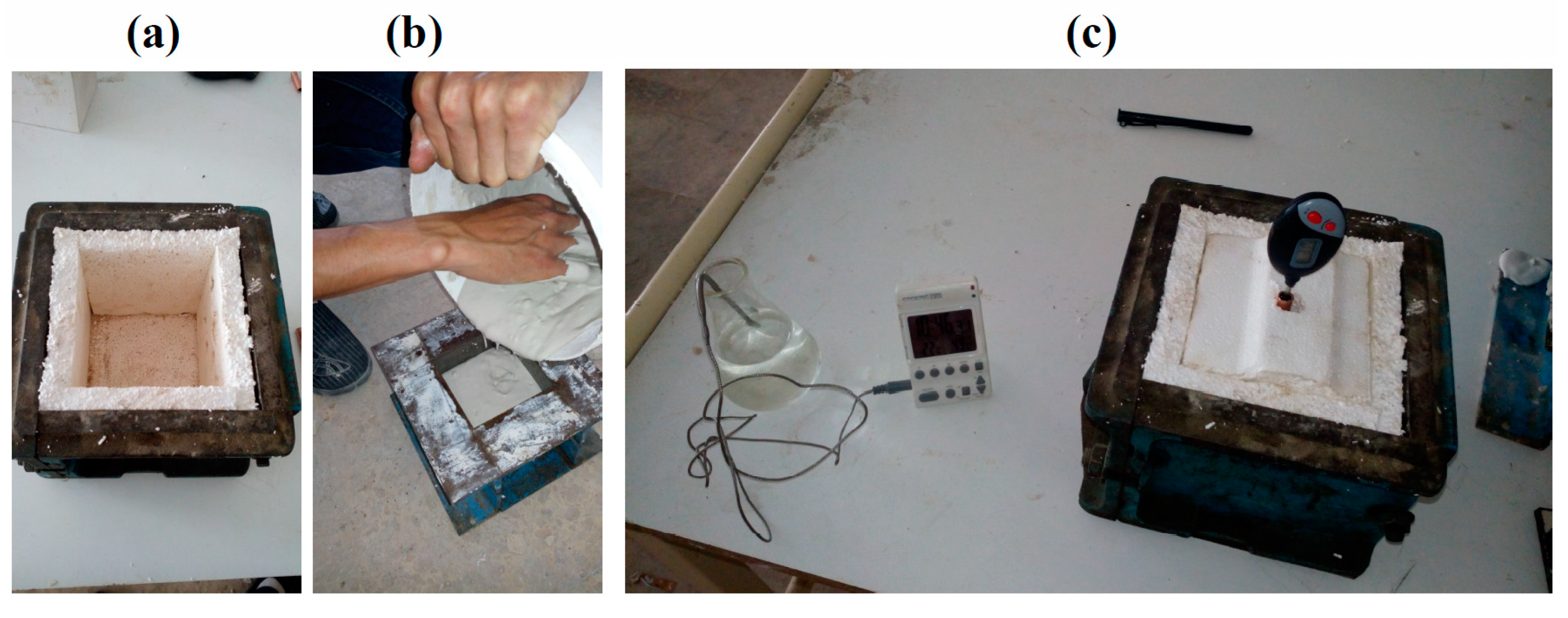
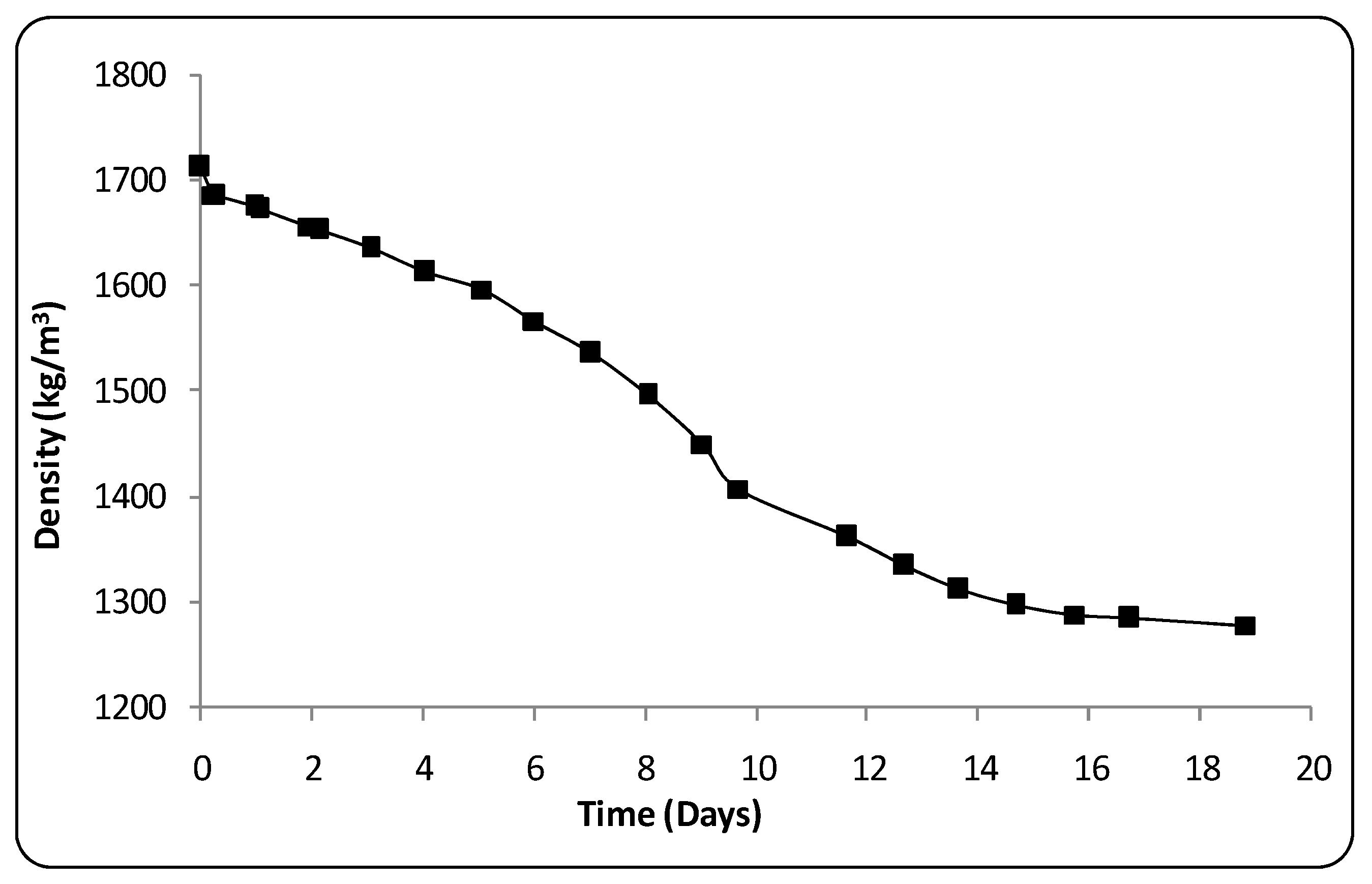
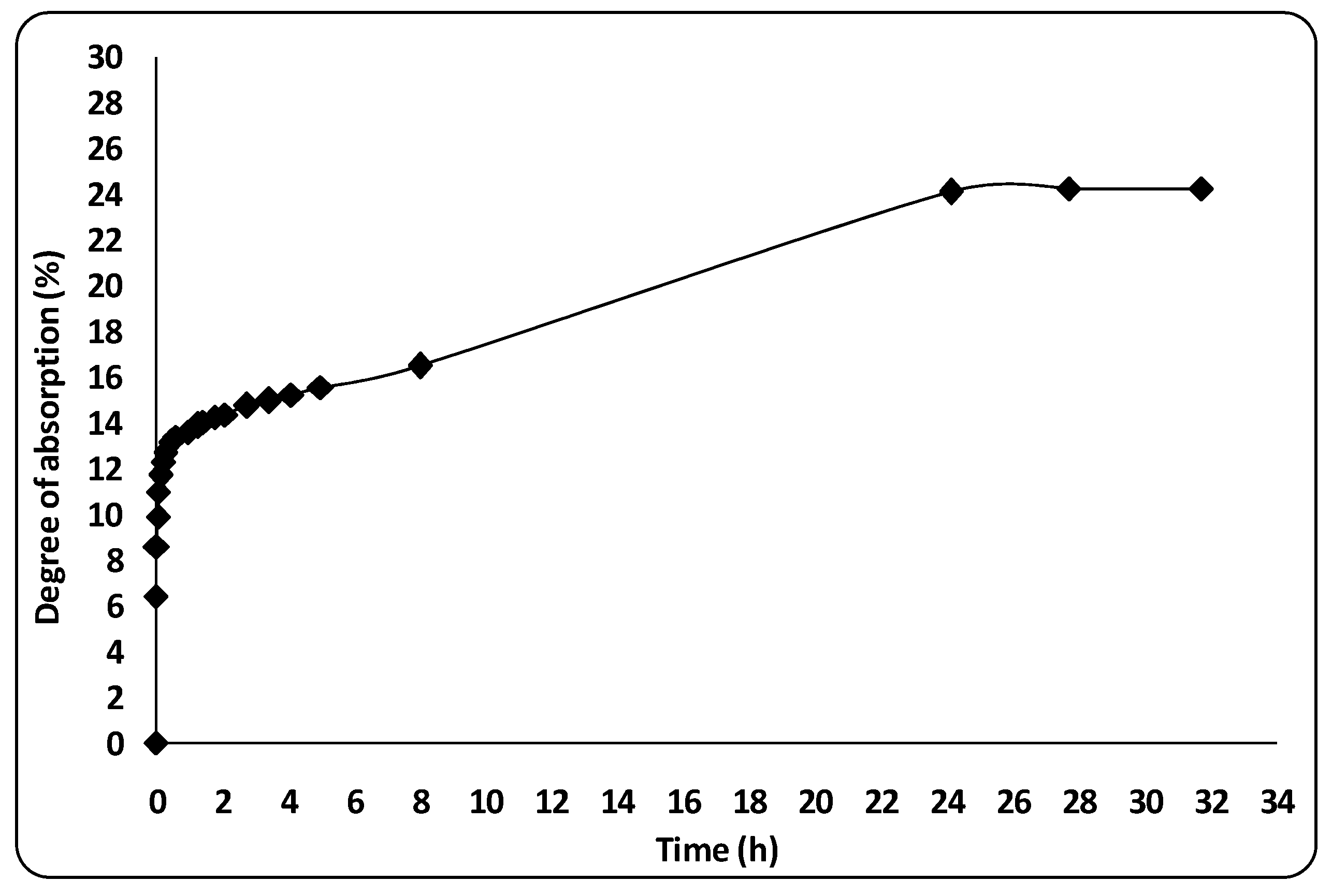
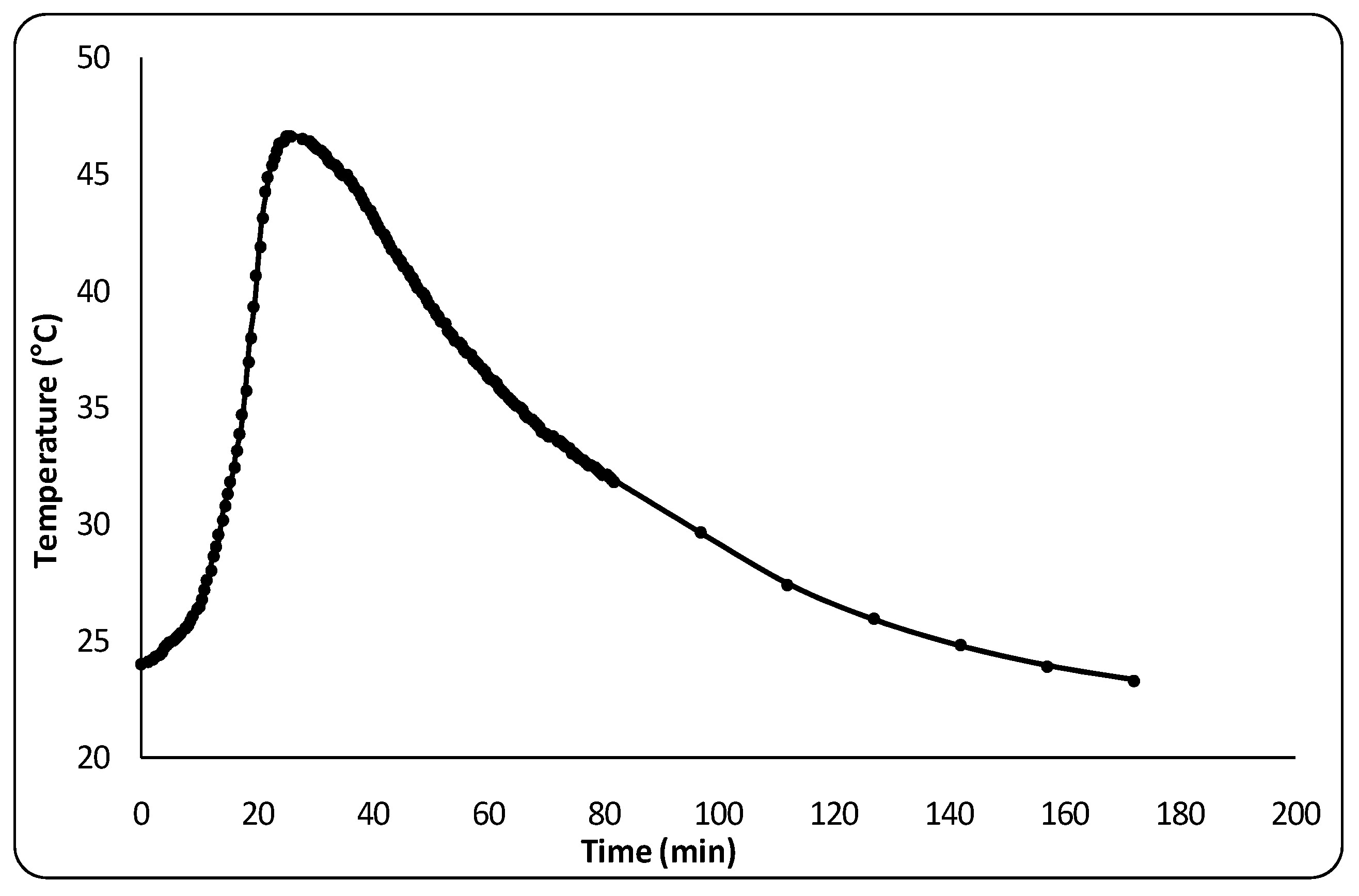
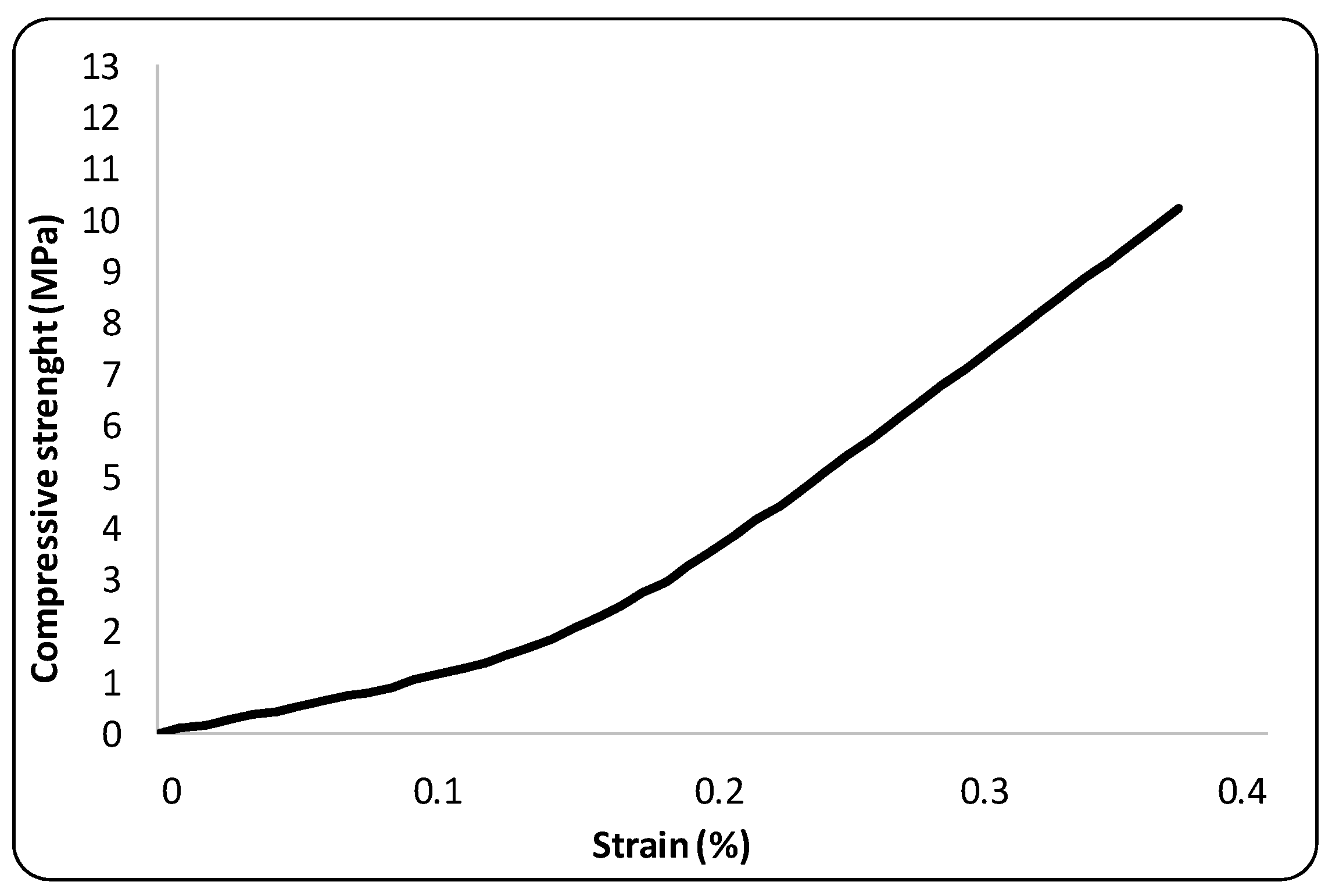
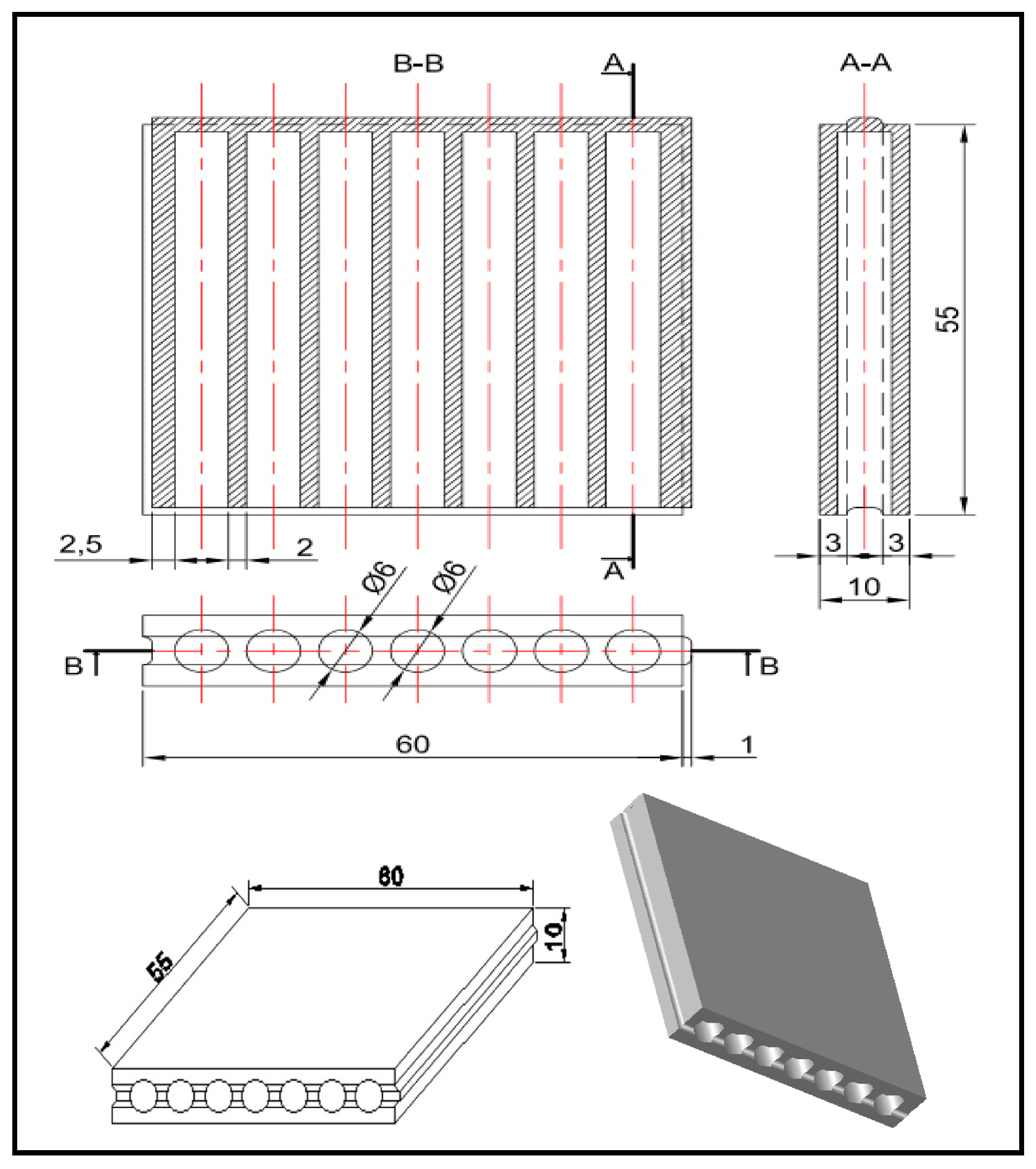
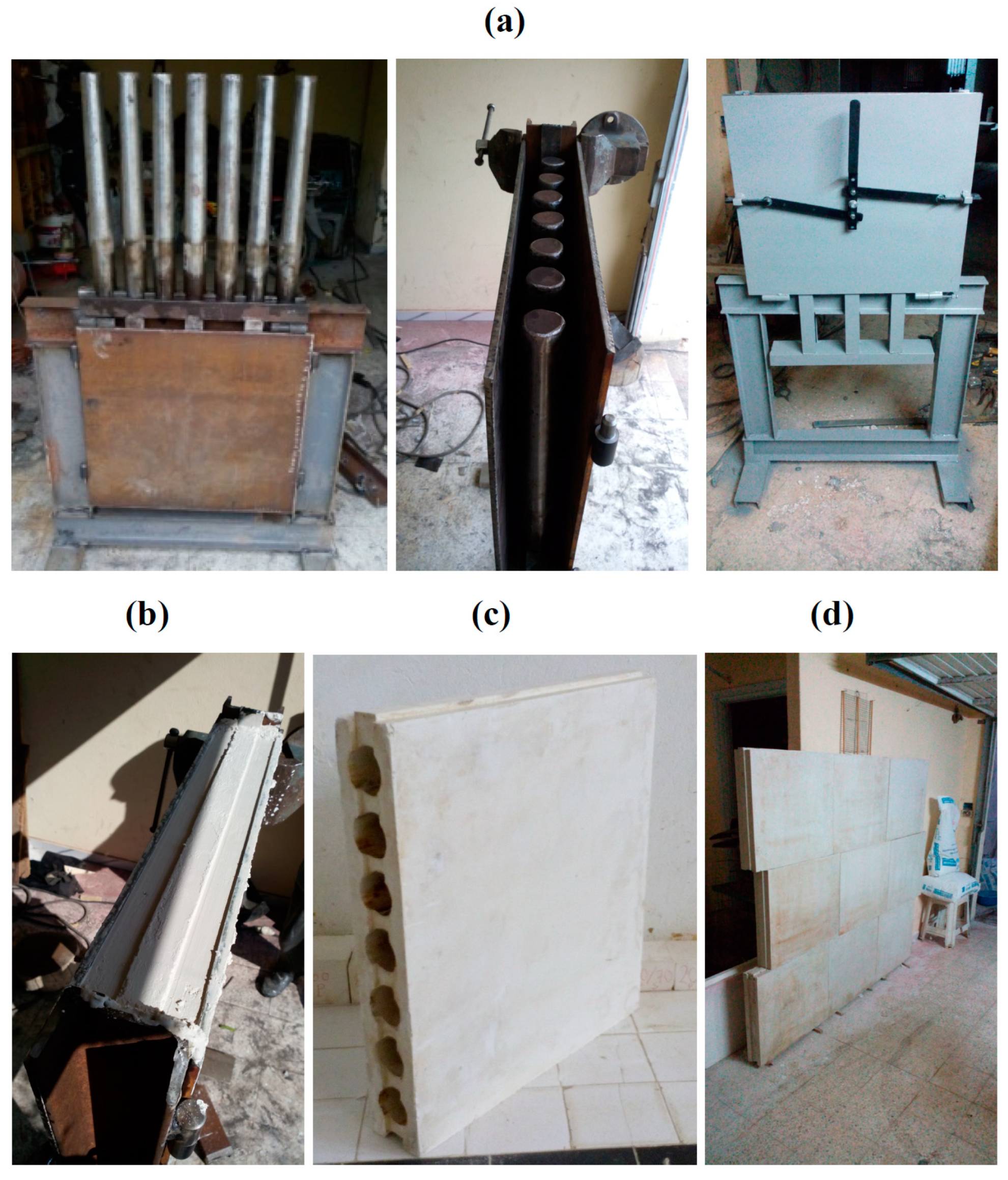

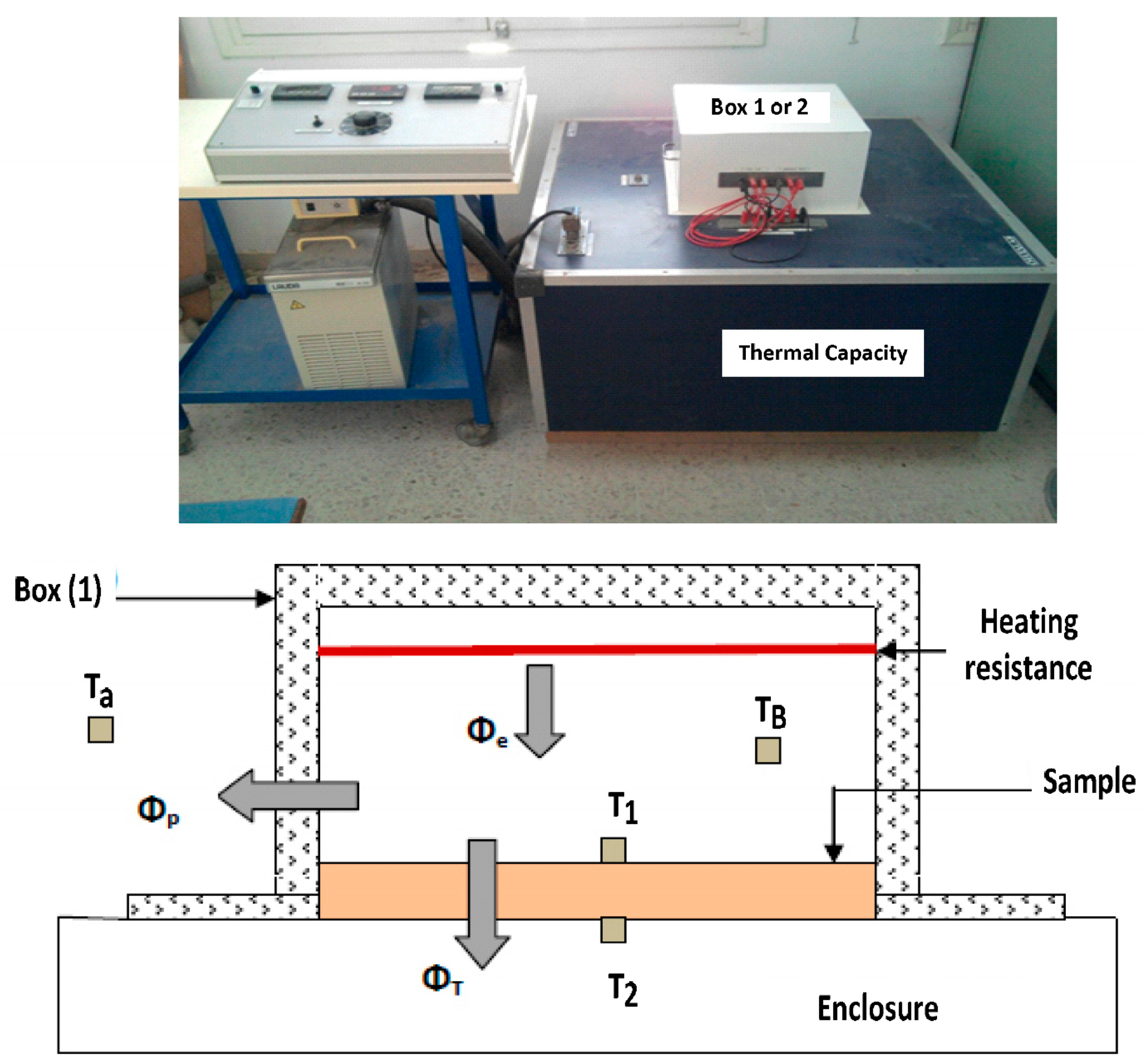

| Component | Al2O3 | CaO | Fe2O3 | K2O | MgO | Na2O | SO3 | SiO2 |
| Percentage | 0.10 | 34.85 | 0.08 | 0.03 | 0.53 | 0.09 | 46.63 | 0.70 |
| Parameters | Particle Size (mm) | Absolute Density (g/cm3) | Bulk Density (g/cm3) | Blaine Specific Surface (BSS) (cm2/g) |
|---|---|---|---|---|
| Standard | NF P 94-056 [22] | NF EN 1097-7 [25] | NF EN 196-6 [24] | |
| Test result | 0/0.5 | 2.65 | 0.60 | 5705 |
| Water/Gypsum plaster | 0.54 | 0.58 | 0.59 | 0.60 | 0.61 | 0.62 | 0.63 | 0.64 |
| Flow time (s) | 5.23 | 4.53 | 3.41 | 2.38 | 1.99 | 1.75 | 1.55 | 1.49 |
| Test | Specimen Shape | Specimen Dimensions | Number of SpecimensbyTest |
|---|---|---|---|
| Density | Cubic | 100 × 100 × 100 mm | 3 |
| Absorption degree | Cubic | 100 × 100 × 100 mm | 3 |
| Hydration temperature | Cubic | 100 × 100 × 100 mm | 3 |
| Compressive strength | Cylindrical | 50 × 100 mm | 12 |
| Initial Density (g/cm3) | Final Density (g/cm3) | Water Loss (%) | Degree of Absorption (%) |
|---|---|---|---|
| 1.711 | 1.278 | 25.30 | 24.3 |
| Age [day] | 1 | 3 | 5 | 7 | 14 | 21 | 28 |
| Compressive strength [MPa] | 6.7 | 6.7 | 6.7 | 6.5 | 8.5 | 11.1 | 11.2 |
| Property | Result | |
|---|---|---|
| Dimensional tolerances (mm) | Length | 600.2 |
| Height | 550.7 | |
| Thickness | 100.3 | |
| Drying time (h) | 48 | |
| Flatness (mm) | 0.5 | |
| Density (Kg/m3) | 856 | |
| Compressive strength (MPa) | 5.6 | |
| Residual moisture (%) | 5 | |
| Water absorption (%) | 24.3 | |
| Surface hardness (shore C) | 35 | |
| Thermal conductivity (W/mK) | 0.45 | |
Publisher’s Note: MDPI stays neutral with regard to jurisdictional claims in published maps and institutional affiliations. |
© 2022 by the authors. Licensee MDPI, Basel, Switzerland. This article is an open access article distributed under the terms and conditions of the Creative Commons Attribution (CC BY) license (https://creativecommons.org/licenses/by/4.0/).
Share and Cite
Binti Katman, H.Y.; Khai, W.J.; Benjeddou, O.; Mashaan, N. Experimental Investigation of a New Design of Insulation Gypsum Plaster Blocks. Buildings 2022, 12, 1297. https://doi.org/10.3390/buildings12091297
Binti Katman HY, Khai WJ, Benjeddou O, Mashaan N. Experimental Investigation of a New Design of Insulation Gypsum Plaster Blocks. Buildings. 2022; 12(9):1297. https://doi.org/10.3390/buildings12091297
Chicago/Turabian StyleBinti Katman, Herda Yati, Wong Jee Khai, Omrane Benjeddou, and Nuha Mashaan. 2022. "Experimental Investigation of a New Design of Insulation Gypsum Plaster Blocks" Buildings 12, no. 9: 1297. https://doi.org/10.3390/buildings12091297






